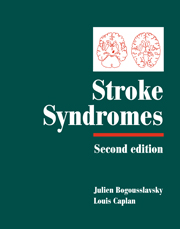Book contents
- Frontmatter
- Contents
- List of contributors
- Preface
- PART I CLINICAL MANIFESTATIONS
- 1 Stroke onset and courses
- 2 Clinical types of transient ischemic attacks
- 3 Hemiparesis and other types of motor weakness
- 4 Sensory abnormality
- 5 Cerebellar ataxia
- 6 Headache: stroke symptoms and signs
- 7 Eye movement abnormalities
- 8 Cerebral visual dysfunction
- 9 Visual symptoms (eye)
- 10 Vestibular syndromes and vertigo
- 11 Auditory disorders in stroke
- 12 Abnormal movements
- 13 Seizures and stroke
- 14 Disturbances of consciousness and sleep–wake functions
- 15 Aphasia and stroke
- 16 Agitation and delirium
- 17 Frontal lobe stroke syndromes
- 18 Memory loss
- 19 Neurobehavioural aspects of deep hemisphere stroke
- 20 Right hemisphere syndromes
- 21 Poststroke dementia
- 22 Disorders of mood behaviour
- 23 Agnosias, apraxias and callosal disconnection syndromes
- 24 Muscle, peripheral nerve and autonomic changes
- 25 Dysarthria
- 26 Dysphagia and aspiration syndromes
- 27 Respiratory dysfunction
- 28 Clinical aspects and correlates of stroke recovery
- PART II VASCULAR TOPOGRAPHIC SYNDROMES
- Index
- Plate section
25 - Dysarthria
from PART I - CLINICAL MANIFESTATIONS
Published online by Cambridge University Press: 17 May 2010
- Frontmatter
- Contents
- List of contributors
- Preface
- PART I CLINICAL MANIFESTATIONS
- 1 Stroke onset and courses
- 2 Clinical types of transient ischemic attacks
- 3 Hemiparesis and other types of motor weakness
- 4 Sensory abnormality
- 5 Cerebellar ataxia
- 6 Headache: stroke symptoms and signs
- 7 Eye movement abnormalities
- 8 Cerebral visual dysfunction
- 9 Visual symptoms (eye)
- 10 Vestibular syndromes and vertigo
- 11 Auditory disorders in stroke
- 12 Abnormal movements
- 13 Seizures and stroke
- 14 Disturbances of consciousness and sleep–wake functions
- 15 Aphasia and stroke
- 16 Agitation and delirium
- 17 Frontal lobe stroke syndromes
- 18 Memory loss
- 19 Neurobehavioural aspects of deep hemisphere stroke
- 20 Right hemisphere syndromes
- 21 Poststroke dementia
- 22 Disorders of mood behaviour
- 23 Agnosias, apraxias and callosal disconnection syndromes
- 24 Muscle, peripheral nerve and autonomic changes
- 25 Dysarthria
- 26 Dysphagia and aspiration syndromes
- 27 Respiratory dysfunction
- 28 Clinical aspects and correlates of stroke recovery
- PART II VASCULAR TOPOGRAPHIC SYNDROMES
- Index
- Plate section
Summary
Introduction
Dysarthria is a pure motor disorder of speech, occurring in 24–29% of patients with cerebral ischemia (Arboix et al., 1990; Melo et al., 1992). It is characterized by dysfunction of the structures implicated in the control, initiation and coordination of speech output: lips, tongue, jaw, and palate, which are innervated by the facial, glossopharyngeal, vagal, and hypoglossal nerves. The dysarthric patient exhibits intact cortical language mechanisms and comprehension, is able to understand perfectly what he hears and has no difficulty in reading and writing, although his speech is inarticulate and may be unintelligible.
Lesions that cause dysarthria may occur in one of several locations along the neuraxis (Schiff et al., 1983; Yorkston et al., 1988). The upper and/or lower motor neuron may be involved as well as the extrapyramidal system from the basal ganglia to the cerebellum. Each region may receive blood supply from more than one artery. The examination of the patient with dysarthria is used to identify the specific type of abnormality. It is conducted by listening to the patient's speech during ordinary conversation, after testwords, or in the attempt of rapid repetition of lingual, labial, and guttural consonants. The clinical features of the dysarthria and the associated neurological findings identify the responsible lesion. Dysarthria has also been described as an isolated symptom (Ozaki et al., 1986; Caplan et al., 1990); in such circumstances the responsible lesion is suggested by the characteristics of the dysarthria itself and by imaging studies.
Defects in articulation may be subdivided into several types: upper motor neuron or spastic (pseudobulbar), lower motor neuron (neuromuscular), cerebellar–ataxic, hypo- and hyperkinetic.
Information
- Type
- Chapter
- Information
- Stroke Syndromes , pp. 334 - 340Publisher: Cambridge University PressPrint publication year: 2001
